
REFRACTION OF LIGHT
Light of Class 9
REFRACTION OF LIGHT
When light travels in the same homogeneous medium it travels along a straight path. However, when it passes from on transparent medium to another, the direction of its path changes at the interface of the two media. This is called refraction of light.
The phenomenon of the change in the path of the light as it passes from one transparent medium to another is called refraction of light. The path along which the light travels in the first medium is called incident ray and that in the second medium is called refracted ray. The angles which the incident ray and the refracted ray make with the normal at the surface of separation are called angle of incidence (i) and angle of refraction (r) respectively.

Incident ray Normal Refracted ray
(a) (b) (c)
Showing different cases of refraction
It is observed that:
- When a ray of light passes from an optically rarer medium to a denser medium it bends towards the normal (∠r < ∠i), as shown in figure (a).
- When a ray of light passes from an optically denser to a rarer medium it bends away from the normal (∠r > ∠i) as shown in figure (b).
- A ray of light traveling along the normal passes undeflected, as shown is figure (c). Here ∠i = ∠r = 0 o .
Cause of Refraction:
The bending is caused by one side of the wave changing speed before the other side. Going from a fast medium into a slower medium will cause the ray of light to bend toward the normal, while going from a slow medium into a faster one will cause the ray to bend away from the normal.
When light goes from air (optically rarer medium) to glass (optically denser medium) such that the light in air makes an angle with the normal to the interface separating air and glass, then it bends from its original direction of propagation. Similarly, if light goes from glass to air, again it bends from its original direction of propagation. The phenomena of bending of light from its path is known as refraction. We have seen that the speed of light in different media is different, so we can say that refraction of light takes place because the speed of light is different in different media. Thus, the cause of refraction can be summarized as follows:
- Refraction is the deviation of light when it crosses the boundary between two different media (of different optical densities) and there is a change in both the wavelength and the speed of light.
- The frequency of the refracted ray remains unchanged.
- The intensity of the refracted ray is less than that of the incident ray. It is because there is partial reflection and absorption of light at the interface.
Effects of refraction of Light:
Due torefractionof light, various effect are observed in ourdaily life. We have many advantages by the refraction of light. The following are some example of them:
- A clearpool of wateralways appears to be shallower than it actually is.
- Acoinplaced at the bottom of beaker containing water seems ti be raised.
- A stick partially dipped inwaterseems to be sent.
- The sun appears flattened at the time of sun set andsun rise.
- The density of the air in the atmosphere is greater near the surface of the earth than above it. Thus, the magnitude of refraction increases withdecreasingheight.Due to this, the lower portions of the sun at the time of sun set and sun rise are raised more than the upper portions. Hence, the vertical diameter of the sun is shortened more than the horizontal diameter.As a result, the sun seems flattened.
- The sun is visible a few minutes earlier than it actually rises above horizon, because as we go up from earth, the density of air layer decrease, then rays from sun keep on bending towards normal till it enters the eye.
Sun appears to be at S’. For the same reason it keeps on appearing two minutes after sun-set. Hence the day i.e. the time between the sunrise & sunset becomes four minutes longer. The day therefore gets longer by 4 minutes.
Twinkling of stars:
The scientific name for the twinkling of stars isstellarscintillation (or astronomical scintillation). Stars twinkle when we see them from the Earth's surface because we are viewing them through thick layers of turbulent (moving) air in theEarth's atmosphere.
Stars (except for the Sun) appear as tiny dots in the sky; as their light travels through the many layers of the Earth'satmosphere, the light of the star is bent (refracted) many times and in random directions (light is bent when it hits a change in density - like a pocket of cold air or hot air). This random refraction results in the star winking out (it looks as though the star moves a bit, and our eye interprets this as twinkling).
LAWS OF REFRACTION:
Refraction of light occurs according to certain laws, known as the laws of refraction. The following are the two laws of refraction:
(i) First law of refraction of light: The incident ray, the refracted ray, and the normal all lie in the same plane.
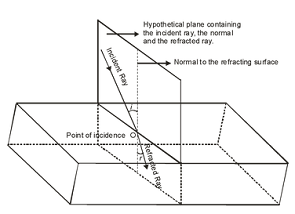
(ii)Second law of refraction: According to the second law of refraction, “The ratio of sine of angle of incidence to the sine of angle of refraction is a constant, for the light of a given colour (wavelength) and for the given pair of media.” This law is also known as Snell’s law of refraction.
i.e., sin i /sin r = constant
where i = angle of incidence
r = angle of refraction.
This constant value is called the refractive index of the second medium with respect to the first.
REFRACTIVE INDEX:
(a) Refractive Index in terms of Speed of Light:
The refractive index of a medium may be defined in terms of the speed of light as follows :
The refractive index of a medium for a light of given wavelength may be defined at the ratio of the speed of light in vacuum to its speed in that medium.
Refractive index =Speed of light in vacuum / Speed of light in medium
or μ = c/v
Refractive index of medium with respect to vacuum is also called absolute refractive index.
(b) Refractive Index in terms of Wavelength:
Since the frequency (ν) remain unchanged when light passed from one medium to another, therefore,

The refractive index of a medium may be defined as the ratio of wavelength of light in vacuum to its wavelength in that medium.
(c) Relative Refractive Index:
The relative refractive index of medium 2 with respect to medium 1 is defined as the ratio of speed of light (v 1 ) in the medium 1 to the speed of light (v 2 ) in medium 2 and is denoted by 1 μ 2 .
Thus,

As refractive index is the ratio of two similar physical quantities, so it has no unit and dimension.
Factors on which the refractive index of a medium depends are as follows:
- Temperature.
- Nature of the surrounding medium
- Nature of the medium.
- Wavelength of the light used.It may be note that refractive index is a characteristic of the pair of the media and also depends on the wavelength of light, but is independent of the angle of incidence.
Physical significance of refractive Index:
The refractive index of a medium gives the following two information’s:
- The value of refractive index gives information about the direction of bending of refracted ray. It tells whether the ray will bend towards or away from the normal.
- The refractive index of a medium is related to the speed of light. It is the ratio of the speed of light in vacuum to that in the given medium. For example, refractive index of glass is 3/2. This indicates that the ratio of the speed of light in glass to that in vacuum is 2 : 3 or the speed of light in glass is two-third of its speed in vacuum.
The absolute refractive index of some material media are as follows:
Table: Absolute refractive index of some material media
|
Material medium |
Refractive index |
Material medium |
Refractive index |
|
Air |
1.0003 |
Canada Balsam |
1.53 |
|
Ice |
1.31 |
Rock salt |
1.54 |
|
Water |
1.33 |
Carbon disulphide |
1.63 |
|
Alcohol |
1.36 |
Dense flint glass |
1.65 |
|
Kerosene |
1.44 |
Ruby |
1.71 |
|
Fused quartz |
1.46 |
Sapphire |
1.77 |
|
Turpentine oil |
1.47 |
Diamond |
2.42 |
|
Benzene |
1.50 |
Crown glass |
1.52 |
THE DIRECTION OF BENDING OF LIGHT:
The two rules which give the direction of bending of a ray of light when it goes from one medium to another are as follows :
- When a ray of light goes from a rarer medium to a denser medium, it bends towards the normal at the interface of the two media.
- When a ray of light goes from a denser medium to a rarer medium, it bends away from the normal at the interface of the two media.
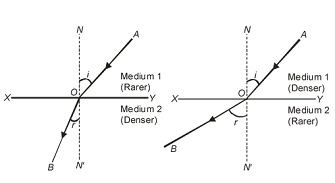
Refractive Index in terms of apparent depth and real depth:
Whenever we observe the bottom of a swimming pool or a tank of clear water, we find that the bottom appears to be raised i.e., the apparent depth is less as compared to its real depth.
The extent to which the bottom appears to be raised depends upon the value of refractive index of the refracting medium.
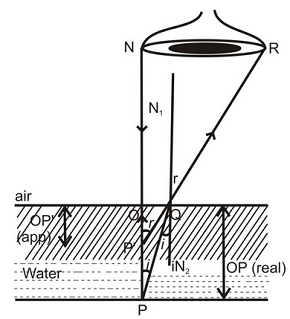
In above fig., ∠PQN 2 = ∠i & ∠N 1 OR = ∠r
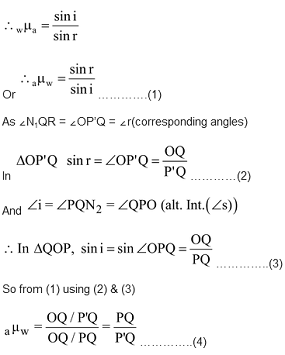
Given ∠I is very small, it is nearly normal direction of viewing.
PQ ≅ PO
& P’Q ≅ P’O
∴ from (4)
 .
.
Refraction and Speed of Light:
The refraction of light occurs because light has different speed in different media. Speed of light is maximum in vacuum or air. It is less in any other medium. Denser in the medium lesser is the speed of light. Refractive index of a medium depends not only on its nature and physical conditions, but also on the colour or wavelength of light. It is more for violet light and less for red light (VIBGYOR).
To find refractive index of two media w.r.t. each other when their refractive indices w.r.t. air are given. A ray of light AB refracts from different medium as shown in figure below.
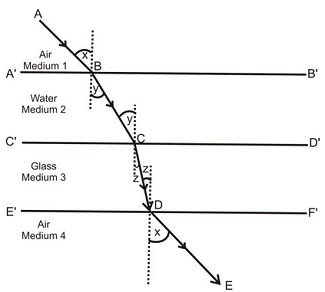
(i)For refractive index at interface A’B’
 ..................(i)
..................(i)
(ii)For refractive index at interface C’D’
 ..................(ii)
..................(ii)
(iii) For refractive index at interface E’F’
 .................(iii)
.................(iii)
Multiply (1), (2) & (3)
 ....................(iv)
....................(iv)
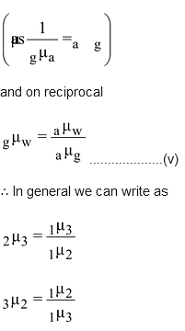
Ex. Calculate the speed and wavelength of light (i) in glass & (ii) in air, when light waves of frequency 6 × 10 14 Hz. travel from air to glass of μ = 1.5.
Solution : Here v = 6 × 10 14 Hz. μ = 1.5
(i)In glass speed of light

Wavelength of light

(ii) In air speed of light V a = 3 x 10 8 m/s
Wavelength of light

REFRACTION THROUGH A GLASS SLAB(considering no absorption):
Refraction through a rectangular glass slab:
Consider a rectangular glass slab, as shown in the figure. A ray AE is incident on the face PQ at an angle of incidence I. On entering the glass slab, it bends towards normal and travels along EF at an angle of refraction r. The refracted ray EF is incident on face SR at an angle of incidence r’. The emergent ray FD bends away from the normal at an angle of refraction e.
Thus the emergent ray FD is parallel to the incident ray AR, but it has been laterally displaced with respect to the incident ray. There is shift in the path of light on emerging from a refracting medium with parallel faces.
Lateral shift:
Lateral shift is the perpendicular distance between the incident and emergent rays when light is incident obliquely on a refracting slab with parallel faces.
Factors on which lateral shift depends are :
- Lateral shift is directly proportional to the thickness of glass slab.
- Lateral shift is directly proportional to the incident angle.
- Lateral shift is directly proportional to the refractive index of glass slab.
- Lateral shift is inversely proportional to the wavelength of incident light.
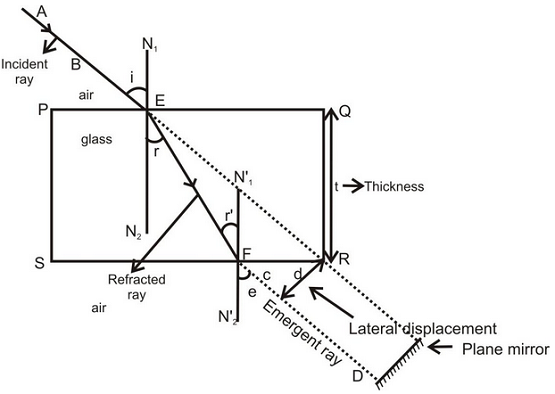
Lateral shifting of light in glass slab
If a plane mirror is placed in the path of emergent ray FD then the path of the emergent ray along FD is reversed back, it follows the same path along which it was incident i.e. the incidence ray becomes the emergent ray & emergent ray becomes the incident ray. It is known as principle of reversibility of light.
Case - I : For light going from air to glass of point E.
∠i = angle of incident, ∠r angle of refraction.

Case - II : For light going from glass to air at point F.
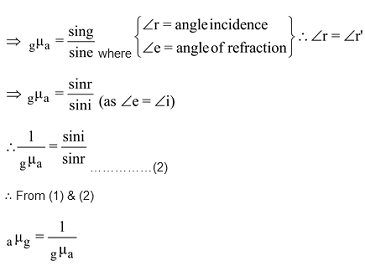
⇒ [ a μ g × g μ a = 1].










